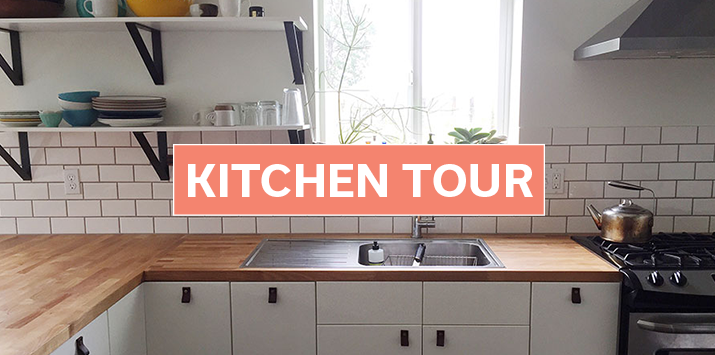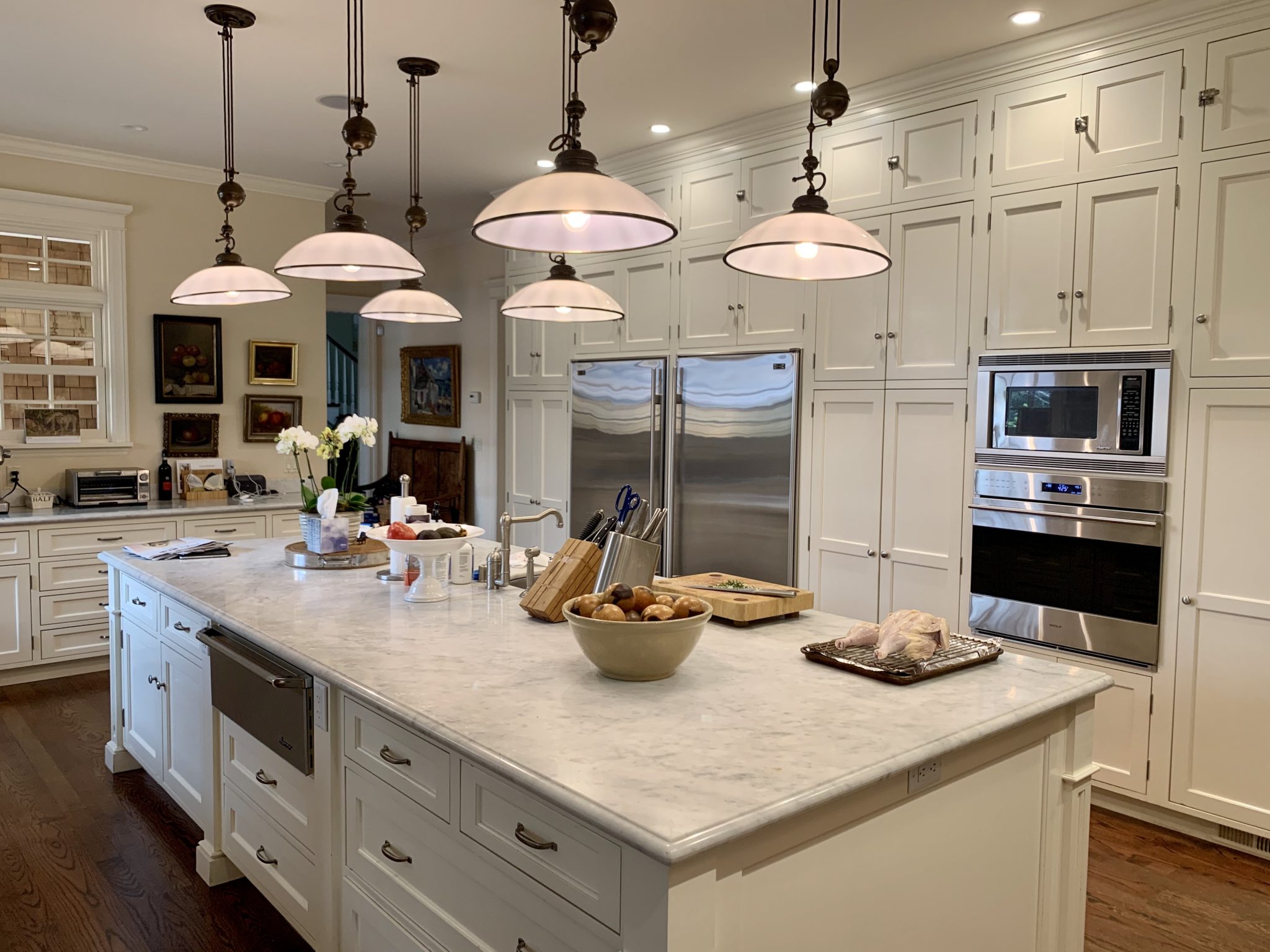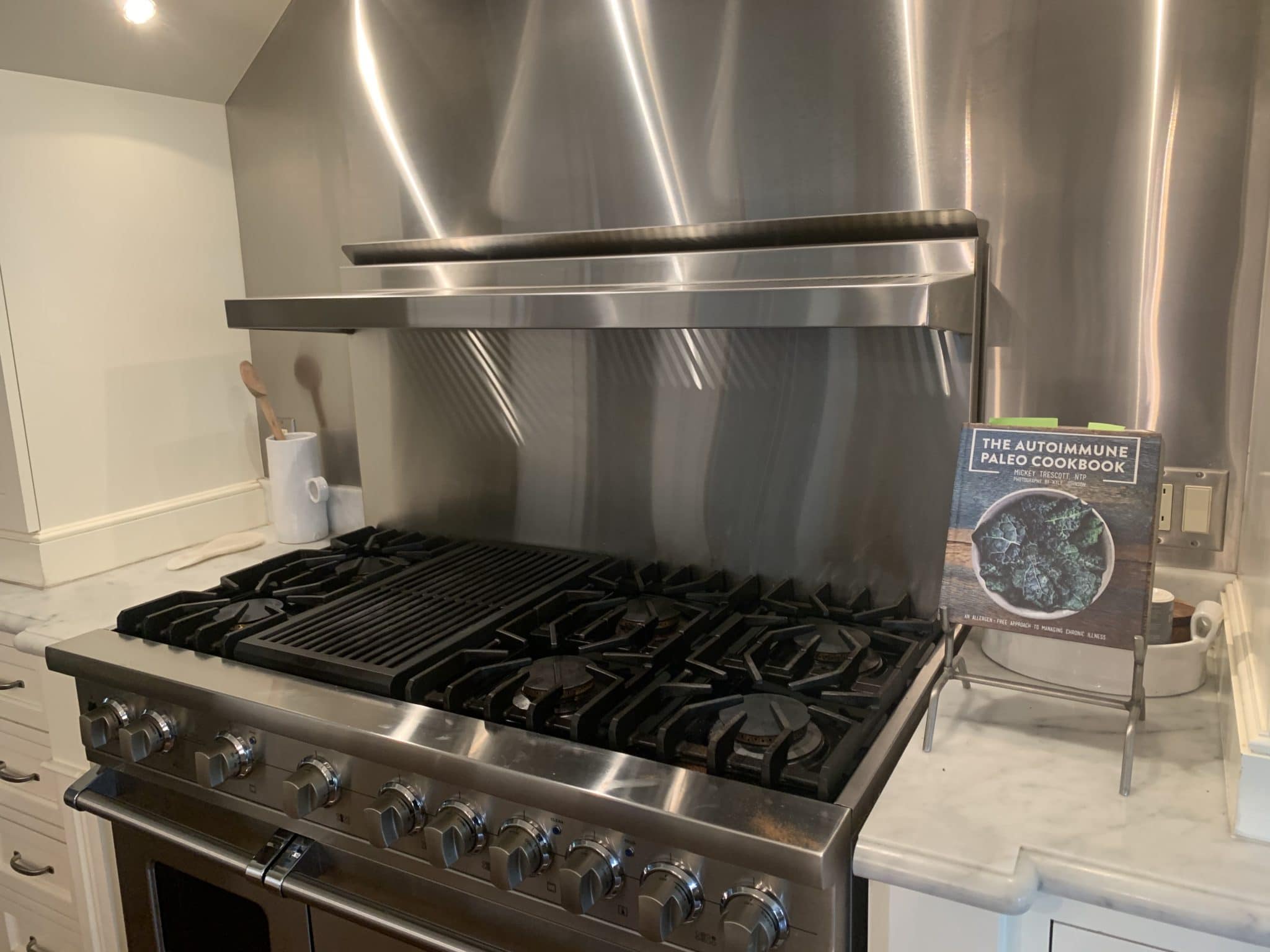This post contains affiliate links. Click here to see what that means!
That being said, we only promote authors, products, and services that we wholeheartedly stand by!

AIP Kitchen Tour is a monthly feature in which we profile a member of the AIP community and their kitchen setup in hopes that it will further inspire us to get our kitchens organized and set up for success! We’ve interviewed folks who are making the AIP lifestyle a reality in everything from college dorms and small city apartments, to large households with non-AIP family members, and everything in between. Through these interviews, we hope to share how they make it happen across a variety of budgets and living situations, and give the community a wealth of inspiration. Read more Kitchen Tours here!

Name: Ellen Rudolph
Location: Bay Area, CA (currently quarantining with my family)
How long have you been eating AIP? About 8 months
Have you successfully reintroduced any foods?
I completed a full AIP elimination phase and since then have successfully reintroduced a number of foods, including seeds (chia and flax), nuts (cashews, walnuts, almonds), eggs, spices (chili powder, paprika), and tomatoes. Recently, I’ve been experiencing a bit of a flare up, so I’m in the process of doing another round of the elimination phase. My goal is to do a better job preparing for the reintroduction process this time around so I get a full understanding of my trigger foods.
How has the AIP changed your life?
I’ve always been a big believer in more holistic ways of healing, so I decided to try to heal my autoimmunity and other chronic conditions through lifestyle factors — including diet, supplements, sleep, reducing stress, etc. After my diagnosis, I immediately read up on everything I could about the autoimmune protocol, and after 8 months of following the protocol, I’ve been able to successfully reverse many of the symptoms and conditions I was experiencing. Since following AIP, I no longer have the brain fog, fatigue, or GI issues that had plagued me for months. It’s also improved my sleep quality and provides me with sustainable energy throughout the day. I finally have enough energy to resume many of the activities I used to do prior to my illnesses, like going for a hike and working an entire day (and I certainly no longer take these days for granted!).
AIP truly transformed the quality of my life — not only putting my disease into remission but, more importantly, empowering me to take control of my health. It has shown me the power of lifestyle changes and that we all have the ability to take ownership of our health, no matter your circumstances.
On top of that, AIP helped me learn how to listen to my body more effectively. It has taught me how to observe the cues my body is sending me (e.g., paying close attention to how I’m feeling after a meal), and I’ve also become much more compassionate towards my body in the process. I’m now better equipped to identify my own triggers and the unique idiosyncrasies of my body, which has helped in predicting and preventing flare ups.
Lastly, AIP has also taught me how to be more innovative when it comes to food preparation. Creativity comes from constraints, and the restrictions have forced me to experiment and find new ways to reproduce some of the non-compliant recipes that I’ve missed. It has also opened my eyes (and my taste buds) to a number of nutrient-dense foods that I likely would have never tried otherwise (looking at you beef liver!).

Size of your kitchen: 30 x 20 feet
Favorite thing about your kitchen:
Lots of light and countertop space. Having multiple dishwashers and ovens also comes in handy for meal prep — I love to batch roast lots of veggies at the same time, and two dishwashers help with the heavy clean up duty.
Least favorite thing about your kitchen:
I’m not sure if we could ever have enough pantry space! I’d love a larger pantry to store all of my compliant items and also a bigger fridge with more dedicated space for produce (we’re constantly overflowing with veggies!).
Are there any cheap gadgets or little tools that you have found make AIP easier?
Two of my favorite cheap tools are a spiralizer and mandoline. When I’m missing pasta, I love making zoodles or sweet potato noodles as an AIP-friendly alternative and find it just as satisfying. My mandoline has come in handy for making beet and other root vegetable chips — they’re one of my favorite snacks to have on hand.
I also prefer olive and avocado oil sprays to pour bottles — it may seem like a small difference but it gives you much more control when you’re batch cooking. Honestly though, all you really need is a high-quality knife and some sheet trays for batch preparation!

What is the biggest thing that changed in your kitchen setup when you adopted the AIP?
The sheer amount of food storage containers we own. I think our supply may have doubled in size! Meal prepping has made a big impact on the ease of following AIP — I always try to keep lots of prepared vegetables and protein options stored in the fridge, so I don’t have to think about it as much on a day-to-day basis. It’s helpful to be able to pop open the fridge and have compliant options that are ready to eat. We’ve also invested in lots of Stasher bags and Souper cubes, which are both great non-toxic, reusable storage option for produce and soups, respectively.
The other big change was the initial transition of replacing non-compliant foods in my cupboard with AIP-friendly ones. Thrive Market has a lot of compliant pantry staples and helped a lot in this process — I used their service to order alternatives to many of my pantry mainstays, particularly for baking and snacks.
If someone was just starting to invest in some useful but more expensive kitchen tools, which one would you tell them to buy first?
I’d recommend either a slow cooker or Instant Pot. I love any appliances that you can set and forget, and both of these are great for making AIP staples like bone broths, stews, and curries.
The latest appliance I recently purchased is a dehydrator, which I’m very excited about. I haven’t gotten to test it out yet, but I’ve heard it’s a great alternative for making DIY beef jerky and dried fruits and veggies.
Are there any tricks you have learned to make AIP work in your space?
I’m a big snacker, so one of my favorite tricks is keeping lots of AIP snacks on hand and, most importantly, visible. We always have roasted veggies in the fridge and bone broth is another personal favorite too. I’ve learned a lot about the importance of environment design — I keep what I want to eat out in the open and things I don’t want either out of my kitchen or physically out of reach. If you know what your temptations for non-compliant items might be and when they’ll happen, you can anticipate those and plan accordingly.
One-tray meals are a game changer too — no matter your kitchen size, no one wants to deal with a bunch of dirty dishes, so I love how these recipes are simple and easy to make and even easier to clean after the fact.
I also try to reduce waste and recycle all elements of whatever I’m cooking, whether it’s making bone broth from leftover chicken bones or making my favorite broccoli “chips” by roasting broccoli stems.

How do you deal with food for family members that are not AIP?
I’m incredibly fortunate that my family has been very supportive of my AIP journey. They understand that it’s a therapeutic diet and have been very vigilant about abiding by the “not allowed” list and finding appropriate substitutes. My parents have been often open to trying new compliant recipes with me, and as a byproduct, they’ve both lost a lot of weight by eating a largely anti-inflammatory diet!
Are there any tools or appliances that you’ve stopped using now that your diet has changed?
A few of the appliances that don’t get as much love lately are my stand mixer and toaster. Most of the baking I do nowadays doesn’t require anything as robust as a mixer, and I don’t have much use for the toaster sans gluten.
After my diagnosis, we tried to remove many potential sources of toxins and did a large overhaul of food storage containers, replacing plastic Tupperware with non-toxic glass containers.
What are your favorite meals to batch cook?
Simply prepared roasted veggies — just salt, pepper (AIP reintro), and some olive or avocado oil! are an incredibly easy staple to batch cook. Meal prepping a few protein options for the week ahead has been helpful as well — the chicken patties and lamb meatballs from The Autoimmune Paleo Cookbook are two current family-favorites. We try to batch cook as much as possible to reduce cooking time during the week and take advantage of leftovers. Soups, stews, and bone broth are other good meals to make in bulk, and I love having frozen cauliflower rice on hand to add to any meal as a rice or grain alternative.
What are your favorite AIP and Paleo cookbooks?
The Autoimmune Paleo Cookbook was the first cookbook I purchased after my diagnosis and has many recipes I would enjoy even if I wasn’t following AIP. Over the past few months, I’ve experimented with numerous recipes and curated 50 of my favorite “non-bland” recipes that have satisfied my cravings for some of my old favorite foods as well. Remember: anti-inflammatory doesn’t have to mean plain — it can be decadent too :).
Do you have any tips for those starting an elimination diet and setting up their kitchens for the first time?
Plan ahead! Preparation is the key to success on AIP. Before starting AIP, be sure to replace all of your non-compliant staples. Set aside an explicit time to put AIP-friendly things where you can easily access them and remove non-compliant items if you choose to. I also plan my meals for the coming week every Sunday. It sets me up for success for week ahead, so I’m never left wondering what I need to buy from the grocery store or what I’m eating on a given day.
Know your moments of weakness and plan for them. Beginning AIP is a big adjustment, and there will always be inevitable temptations. Whether it’s a nightly craving for dessert or a love for salty snacks, it’s helpful to identify those tendencies beforehand and to have an AIP alternative or substitute ready. In my case, I’ve replaced evening treats with a ritual of making herbal tea after dinner.
Stock your freezer with lots of frozen vegetables (organic if possible!). They tend to be cheaper than fresh vegetables and they’re frozen at their peak ripeness, so they have the most nutritional value.
Keep a list of compliant and non-compliant foods on-hand. While a print out can be helpful if you find yourself having trouble remembering what’s allowed vs. what isn’t, this isn’t even necessarily so much for yourself as it is for others you’re living with. It serves as a good reference and reminder for those around you to be mindful and respectful of the journey you’re on.
Involve others in your process and journey. Meals are inherently communal, so it can be isolating to be following a different diet from others in your life. I’ve found that cooking AIP meals with my family has educated them on the healing properties of food and also made it a much more enjoyable process. Getting their support has also helped with accountability as well.
You can connect with Ellen via her weekly newsletter (sign up here), on her website or on Twitter.
Would you like to be featured in an AIP Kitchen Tour? We feature members of the community who are willing to share the real spaces where they cook, as well as their stories of transitioning to this lifestyle. If you are interested, fill out our interest form!
















0 comments